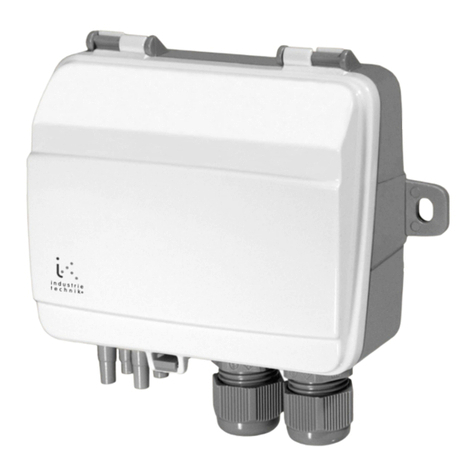
TVAN 2
Technical Data
Supply voltage 24 V AC/DC ± 20 %
Power consumption 5 VA
Wiring Screw terminals
Ambient temperature -10...+50°C
Storage temperature -30...+50°C
Time constant 1,5 s at 10 m/s
Protection class IP65
Inputs
Sensor element Thin lm element
Working range 0...10 / 0...15 / 0...20 m/s, selectable
Accuracy
Range 0.2...10 m/s ±(0.2 m/s + 3% of value)
Range 0.2...15 m/s ±(0.2 m/s + 3% of value)
Range 0.2...20 m/s ±(0.2 m/s + 4% of value)
Response time Selectable 0.7 or 4 s
Outputs
Output 0...10V DC or 4...20 mA, selectable
External load impedance
0...10 V output signal > 10 kΩ
4...20 mA output signal < 500 Ω
EMC emissions & immunity standards
This product conforms to the requirements of the EMC Directive
2014/30/EU through product standards EN 61326-1 and
EN 61326-2-3.
RoHS
This product conforms to the Directive 2011/65/EU of the European
Parliament and of the Council through standard EN 50581:2012.
Contact
AB Industrietechnik srl - Via Julius Durst, 70
39042 BRESSANONE (BZ) Italy
Tel.: +39 0472/830626
Trasmettitore di velocitá dell´aria da condotta
TVAN è un trasmettitore di velocità dell’aria da condotta utilizzato per
la misurazione della velocità del usso nelle unitá di trattamento aria.Il
funzionamento del trasmettitore si basa sul principio dell’anemometro a
lo caldo.
L’uscita può essere impostata a 0 ... 10 V o 4 ... 20 mA.
Per garantire la massima precisione a diverse velocità, è possibile impo-
stare tre diversi campi di misura riferiti al segnale di uscita.
È possibile scegliere tra due tempi di risposta del segnale di uscita differenti.
Installazione
É importante che l’unità sia montata in modo tale che la direzione dell’apertura
della testa del sensore corrisponda alla direzione del usso d’aria (all´interno
della custodia é rafgurata una freccia che indica il senso del usso).
Praticare un foro da Ø16 mm nella parete del canale. Per misurazioni
ottimali, rilevazioni in prossimitá di ussi d´aria turbolenta dovrebbero
essere evitati. Preferibilmente, la misurazione deve essere eseguita ad
una distanza di 2 diametri condotto prima di una curva/ramicazione e a 6
diametri condotto dopo una curva/ramicazione.
Tenere la angia contro il foro e praticare i fori di ssaggio con la
angia come modello.
Fissare la angia.Montare lo stelo del sensore attraverso il foro della
angia e ssarlo alla profondità desiderata.
È possibile, inoltre, montare il trasmettitore utilizzando i fori per viti sul
contenitore.
In entrambi i casi è fondamentale posizionare l’apparecchio in modo
che il usso d’aria attraverso l’elemento sensore sia diretto e libero da
ostacoli.
ISTRUZIONI
TVAN
Consultare la documentazione per tutti i casi in cui
viene utilizzato il simbolo per individuare la natura
dei potenziali rischi e le azioni da intraprendere
IT
CORRETTO ERRATO
Velocitá aria lunghezza di inserimento
30 - 50 % del diametro tubo
Corretto Errato
Velocitá aria Velocitá aria
<16 mm
60 mm
Velocitá aria





















